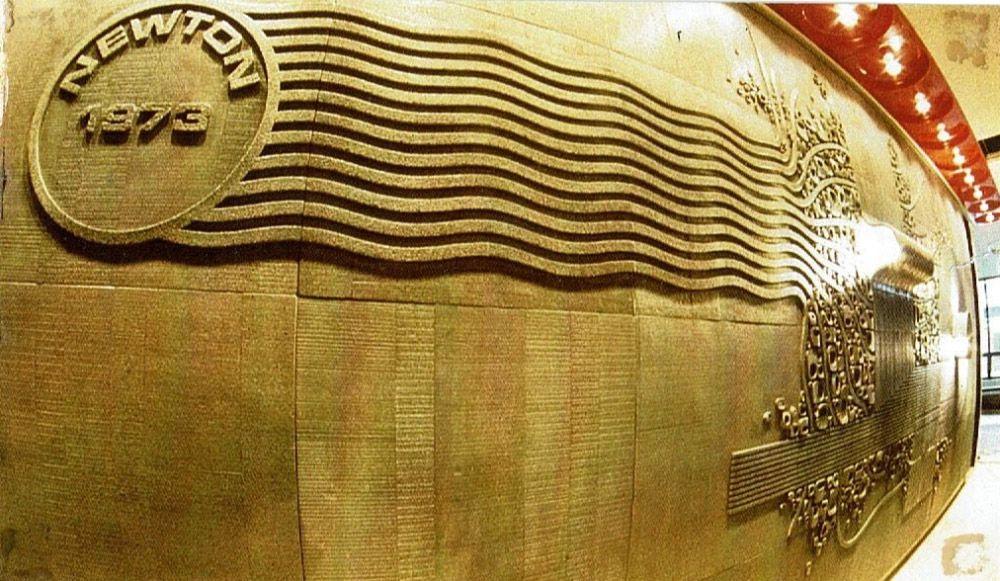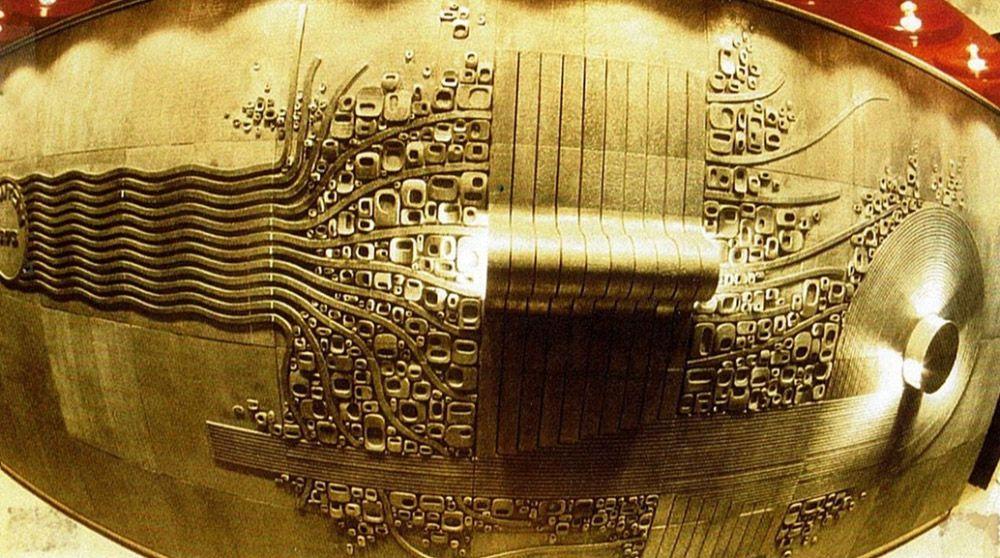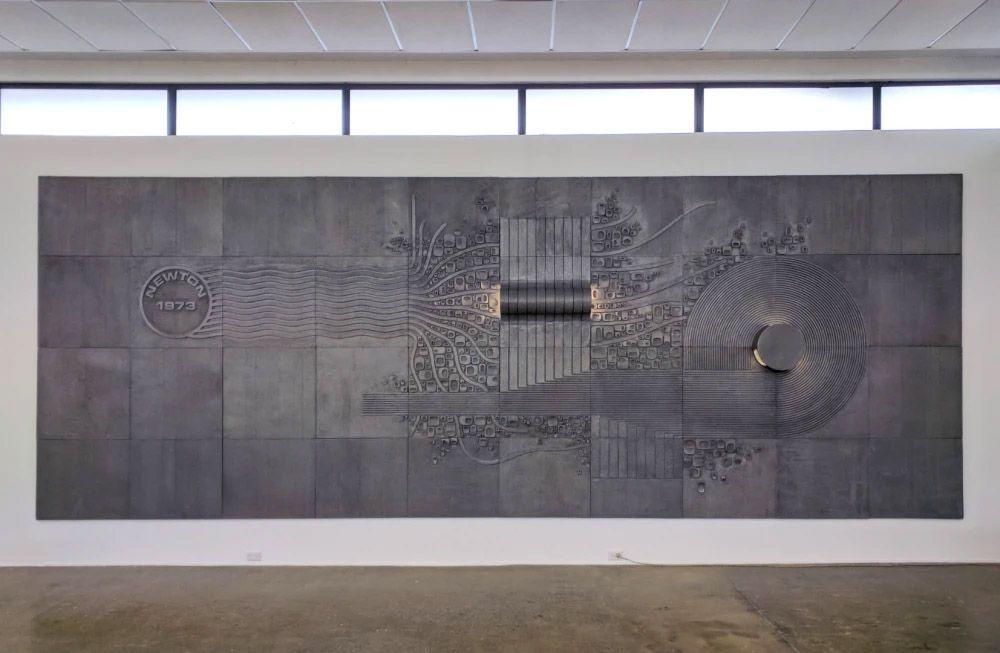Newton Post Office Mural
Guy Ngan
Type
- Mural
Medium
- Aluminium
- Lighting
Dimensions
- H2900mm x W7250mm

Guy Ngan, 'Newton Post Office Mural' (1973) [installed at Artspace as part of the exhibition Guy Ngan: Either Possible or Necessary], Newton, Tāmaki Makaurau Auckland
Source: Bronwyn Holloway-Smith, 2019.



- DETAILS
- MAP
Description
The work is composed of 41 aluminium panels/pieces with built-in lighting.
"In the Sixties and Seventies Guy Ngan was a public art insider, an artist working with architectural practices and the Ministry of Works. A Wellingtonian, he designed many pieces for buildings in the capital, including a large tapestry in the Beehive. In a period of expansionist “think big” government spending, his public work was caught up in a bureaucratisation of modernist precepts and forms.
Ngan’s mural was made for Auckland’s Karangahape Road Post Office, commissioned by the Ministry of Works and designed by architects Mark-Brown Fairhead and Sang. 3 metres tall and 7 metres wide, it is made of interlocking cast aluminium panels arranged in a 4 by 10 grid. The work was constructed using a novel “lost polystyrene” process. The panels were initially carved from expanded polystyrene – the ubiquitous lightweight packing material. Aluminum was then poured into moulds encasing the carvings, vapourising them in a noxious puff. The fine porous texture of the sawn and sanded polystyrene remains visible on the mural’s soft grey surface. In a fascinating doubling of materials, the light, fragile and disposable polystyrene is replaced by silvery aluminium. Aluminium itself is a paradigmatic modern metal; displayed in ingots next to the Crown Jewels in the Paris Exhibition of 1855 and not producible in commercial quantities till 1886. Its lightness and strength made it a post-war stalwart of the aerospace industry. Ngan’s first use of Aluminium was in a mural for the Invercargill Centenary in 1971. Comalco, the artwork’s commissioner, operate New Zealand’s only Aluminium smelter at Tiwai Point in Southland. The smelter began operations that same year.
Depicting postal and telegraphic communication, the 'Post Office Mural’s' semi-abstraction typifies modernist-inspired public art of the period. From the left, wavy lines emanating from a postmark bearing the words “Newton 1973” in Eurostyle font (favourite of late modernist architects everywhere) diverge into what could read as roads or telephone lines. The lines snake through a cluster of lozenge forms – houses, stylised letters or perhaps packets of information – before shooting out beyond the abstracted conurbation.
Near the centre of the mural, a broad strip of parallel lines moving from the top swoops down over an inbuilt light, before merging with a narrower horizontal band and another broad strip from the bottom of the mural. The converging sweep of lines then encircle a domed light, forming a motif that is part stylised koru, part motorway interchange.
The sinuous lines cutting between the clustered hollow lozenge forms recall a feature of the Newton landscape under construction at the same time as the Post Office building – the sweeping camber of ‘spaghetti junction’, Auckland’s most vexed piece of roading. Contemporary aerial views show the new motorway interchange cutting through the old central suburbs in just the way the sweeping lines zoom through the mural’s clustered forms, before trailing off into the aluminium countryside. To extend the reading of the mural in terms of this very new and dominant feature of the local landscape, the vertical band which loops over the first inbuilt light could be seen as referencing the Karagahape motorway overbridge. Just a block down the road from the Post Office, the bridge was constructed as part of the same major roading development (and also under the auspices of the Ministry of Works).
The mural evokes a sense of movement, while its abstraction allows a multiple reading of its moving, sweeping lines: as roads, as phone cables and as lines of flow. In its evocation of two modes of communication — post and telegraphy — the mural works at the cusp of the twentieth century’s major communicational shift – from object transfer to information transfer, from physical to electronic information.
Ngan’s mural was positioned in the building’s street level public area, filling an entire curtain wall. It was lit from above by spotlights in orange plastic dome fittings and skirted at its base by heavy-duty black plastic; the two lights built into the surface added focal illumination. The mural was decommissioned when the building was remodeled following the Post Office’s Rogernomic restructuring and the subsequent subleasing of parts of the building in the late 1980s. It remained in basement storage for a decade, only resurfacing in 1999 when I included it in my Artspace show, Nostalgia for the Future. Artspace is situated on the first floor of the Post Office building, so it seemed a highly appropriate context for a work designed in conjunction with the building’s construction.
In the 1970s a critic condemned the 'Post Office Mural' as depthless décor, but today Ngan’s futuristic artwork seems stylish and dynamic, a social artefact representing a free-spending, infrastructure-happy governmental culture."
~ quoted from Stella Brennan, 'Guy Ngan Mural for the Newton Post Office 1973'.
See also:
- More from Stella Brennan.
